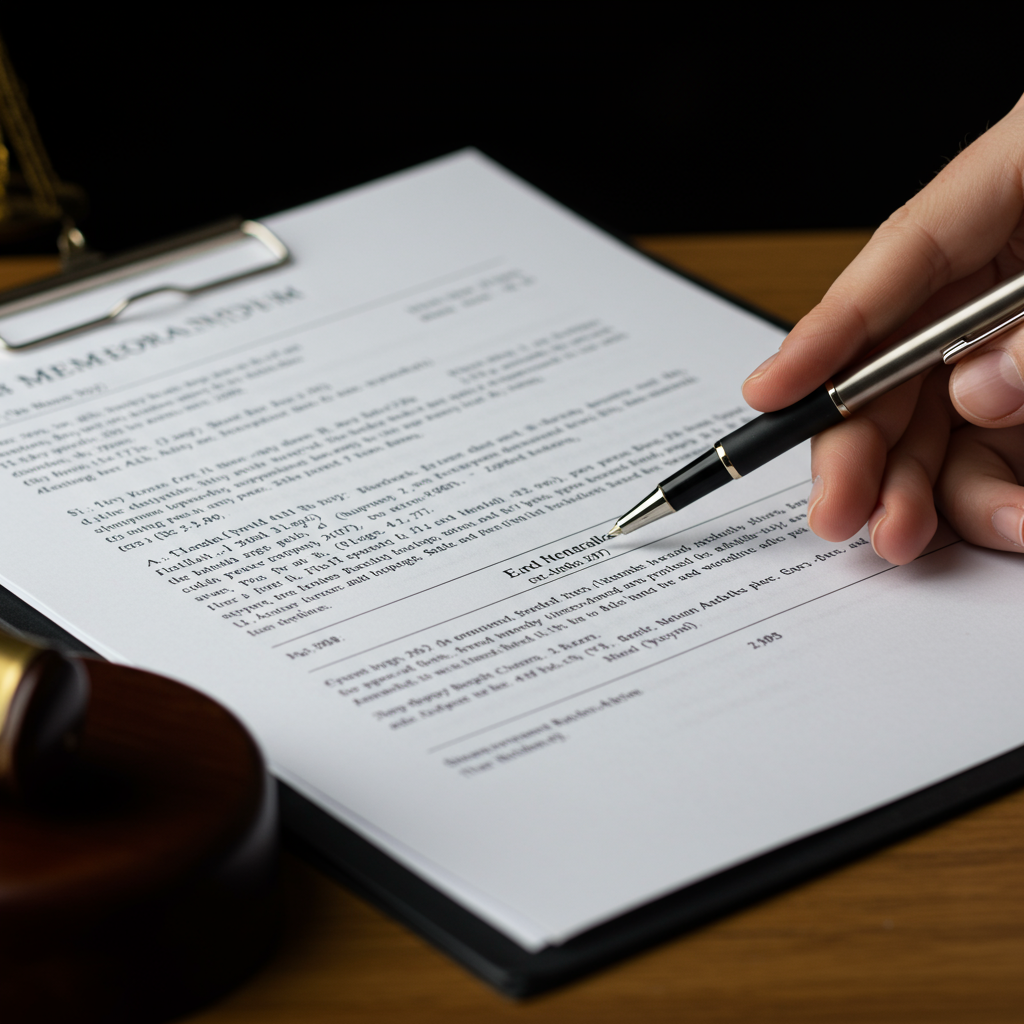
Table of Contents
Introduction
Have you ever wondered how legal professionals communicate complex legal issues clearly and persuasively in writing? The answer often lies in a crucial document known as a legal memorandum. Whether you’re a law student learning the ropes or a legal practitioner sharpening your skills, understanding how to write a precise and effective legal memo is essential. This guide walks you through the process step by step, empowering you to master a foundational legal writing skill that influences decision-making and legal strategy.
In the world of law, a legal memorandum serves as an internal communication tool that presents legal analysis, research findings, and recommendations in a clear, organized format. Unlike court briefs aimed at persuading judges, memoranda help lawyers, paralegals, and clients understand legal issues thoroughly before taking action. The significance of a well-crafted legal memorandum cannot be overstated—it fosters sound legal reasoning, helps anticipate challenges, and ensures that all parties are aligned on legal interpretations. For anyone dealing with legal matters or contracts, drafting a legal memorandum with accuracy is paramount to success.
Legal practice often revolves around attention to detail and clear articulation of complex information. Crafting a legal memorandum requires thorough research, logical organization, and objective analysis. This is especially true in specialized contexts such as investment law, contract disputes, or regulatory compliance. For instance, when analyzing financial data or corporate transactions, understanding how to read financial statements and how to calculate investment returns becomes important for integrating solid evidence into your memorandum. Many find that a legal memo also serves as a blueprint for advising clients or preparing court documents, making your ability to write well-structured memos indispensable.
For those investing in a legal career, mastering memorandum writing enhances both legal understanding and professional credibility. Even for professionals outside traditional legal roles, such as compliance officers or financial consultants, knowing how to convey legal reasoning clearly adds tremendous value. Whether you aim to specialize in this skill or simply want to improve your legal communication, developing competence in legal memorandum writing opens doors to better analysis, clearer advice, and stronger professional relationships.
What You’ll Learn in This Guide
This comprehensive guide will walk you through the essentials of writing a compelling and effective legal memorandum. You’ll gain practical, step-by-step instructions tailored to both novices and those seeking a refresher on best practices.
- Understanding the Legal Memorandum: You’ll learn what constitutes a legal memorandum, why it is a critical tool in legal research and communication, and how it differs from other legal documents.
- Breaking Down Key Components: We’ll explore the essential sections of a memo, including the heading, question presented, brief answer, facts, analysis, and conclusion to ensure your memo covers all necessary elements.
- A Step-by-Step Writing Process: Follow a logical approach from researching the legal issues and outlining your memo to writing clear analyses and reviewing your draft with professional polish.
- Tips and Common Pitfalls: Identify typical mistakes like poor organization and lack of proper citation, plus best practices for concise, objective, and professional writing style.
Throughout this guide, you’ll also see how strong research foundations support your legal arguments. For example, understanding how to read financial statements or learning how to calculate investment returns will enhance the quality of your legal analysis when dealing with investment-related matters. Additionally, knowing about best stocks for dividend growth might provide useful context in financial dispute resolution memos.
In the sections that follow, you can expect detailed explanations and examples that demystify the memorandum writing process. We’ll cover each component’s purpose and structure, so you can confidently assemble your own memos that meet professional standards. Whether you’re drafting your first memo or refining your technique, this guide will help you produce well-crafted documents that effectively communicate your legal research and analysis.
By the end of this guide, you will not only understand how to write a legal memorandum but also appreciate its broader role in legal practice and how to leverage it for clear, concise, and persuasive communication. This knowledge is invaluable whether you are working in law firms, corporate legal departments, government agencies, or academic settings. So, let’s embark on this journey to strengthen your legal writing and research skills and make your memo writing a powerful asset in your legal toolkit.

Having introduced the foundational concept of a legal memorandum and its pivotal role in legal practice, we now turn to a detailed exploration of how to craft an effective legal memorandum. Understanding the purpose and core structure is essential for producing clear, persuasive, and professional legal documents. This discussion will guide you through the key components that every memorandum should include, along with practical steps for writing and refining your memo to meet the rigorous demands of legal research and communication.
Key Components of a Legal Memorandum
A well-structured legal memorandum serves as a comprehensive tool for legal analysis and communication, ensuring clarity for both the writer and the reader. Each section has a distinct function, collectively presenting a logical and persuasive argument. Familiarity with the key components is fundamental to mastering memorandum writing, as it promotes a systematic, professional approach and helps avoid common pitfalls. To fully grasp this concept, it helps to explore foundational legal writing principles and legal terminology that underpin effective memoranda.
These components not only organize your thoughts but also demonstrate your legal reasoning comprehensively, supporting sound decision-making and advising clients or colleagues effectively. The structure encourages thorough research and analysis, providing a roadmap to present complex legal issues with clarity and precision.
Key Aspects of Legal Memorandum Structure
The essential parts of a legal memorandum form the backbone of professional legal writing. Here’s a detailed look at each element:
- Heading: Sets out the writer, recipient, date, and subject, establishing the context and ensuring clear identification of the document.
- Question Presented: Articulates the precise legal question or issue the memorandum addresses. A well-crafted question guides the entire analysis.
- Brief Answer: Provides a succinct conclusion or position on the question presented. This section offers a quick reference summary of your findings.
- Facts: Details all relevant facts necessary for understanding the context. Accuracy here is critical, as the legal analysis depends on these facts.
- Discussion or Analysis: The core of the memorandum where statutes, case law, and legal principles are analyzed in relation to the facts. This section uses reasoned arguments, citations, and logical structure to support conclusions.
- Conclusion: Summarizes the analysis succinctly, reiterating the recommended legal position or action based on the preceding discussion.
Step-by-Step Guide to Writing a Legal Memorandum
Writing an effective legal memorandum requires a clear process that emphasizes thorough research, thoughtful organization, and careful drafting. Following a methodical approach minimizes errors and enhances the clarity and impact of your legal analysis. Professional legal writers recommend segmenting the writing process into manageable steps to maintain focus and ensure accuracy.
Each stage builds on the previous, culminating in a polished, persuasive document suited for internal communication or client advising. Whether you are a law student or legal professional, adhering to this approach strengthens your ability to convey complex legal information clearly and confidently. For a detailed breakdown of this step, see our guide on writing legal briefs, which shares similarities and valuable cross-skills for memorandum writing.
Important Considerations for Legal Memorandum Writing
The careful steps outlined below will assist you in creating a memorandum that aligns with professional standards and serves its intended purpose effectively:
- Research the Legal Issues: Gather all pertinent statutes, case law, regulations, and jurisdiction-specific information. Accurate and comprehensive legal research is the foundation of a strong analysis and valid conclusions.
- Outline Your Memo: Organize your thoughts and legal arguments in a logical sequence. An effective outline includes the major headings and subheadings, which frames your analysis clearly and ensures you cover all necessary points.
- Write Clear and Concise Analyses: Explain the law as it applies to the facts succinctly, using reasoned arguments backed by authoritative citations. Avoid jargon or ambiguous language to maintain readability and effectiveness.
- Review and Edit: Careful proofreading ensures legal accuracy, clarity, grammatical correctness, and consistent formatting. Editing also eliminates overgeneralizations and refines your logical flow, strengthening overall impact.

Summary
In this guide, we have explored the essential components of legal memorandum writing and its significance in the legal field. A legal memorandum serves as a crucial tool for lawyers to communicate complex legal issues in a clear and organized manner, ultimately aiding in effective decision-making. Key components of a well-structured memorandum include the heading, question presented, brief answer, facts, discussion or analysis, and a conclusion. Each of these elements plays a fundamental role in ensuring that legal arguments are articulated in a manner that is both thorough and accessible to the intended audience.
Furthermore, the step-by-step approach to drafting a legal memorandum outlined in this guide emphasizes the importance of thorough research, logical organization, and clear writing. It is crucial to avoid common pitfalls, such as overgeneralization, poor organization, and improper citation, to strengthen your legal arguments and produce compelling memoranda. Clarity and professionalism in writing are paramount, as they reflect your legal competence and attention to detail. Whether you are a law student or a practicing attorney, mastering the art of writing legal memoranda can enhance your communication skills and contribute positively to your legal career.
Actionable Next Steps
Armed with the knowledge you’ve gained from this guide, the next steps involve practicing your legal writing skills. Begin drafting your own legal memoranda using the outlined components and step-by-step approach. Utilize resources such as legal writing manuals and templates to assist you in your practice. Consider seeking feedback from peers or mentors to refine your writing further. Additionally, familiarize yourself with legal research tools and databases to ensure your arguments are well-supported and robust.
Enhancing your research abilities will also play a vital role in the quality of your memoranda. Leverage online resources, legal journals, and case law databases to conduct comprehensive research. Engage in workshops or courses focused on legal writing and analysis to further develop your skills. By diligently practicing and seeking continuous improvement, you will strengthen your ability to produce clear, concise, and persuasive legal memoranda.
Closing Statement
In conclusion, mastering the art of writing a legal memorandum is a vital skill for any legal professional. It reflects not just your understanding of the law, but also your capacity to communicate complex information effectively. By following the steps outlined in this guide, you will be well on your way to crafting effective legal memoranda that serve your legal practice comprehensively.
Further Reading
For more resources, check out our guides on how to read financial statements and how to calculate investment returns.
Frequently Asked Questions
-
What is the difference between a legal memorandum and a legal brief?
- A memorandum is an internal document analyzing legal issues; a brief is often filed in court.
-
How long should a legal memorandum be?
- Length varies but should be concise, clear, and thorough enough to explain the issue.
-
What citation style should I use?
- The Bluebook is commonly used for legal citations in U.S. law.
-
Can law students write legal memoranda?
- Yes, writing memoranda is a fundamental skill taught in law school.
-
What are common pitfalls to avoid in legal memo writing?
- Being too vague, poor organization, and lack of proper citations.
